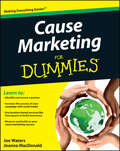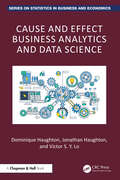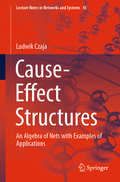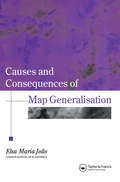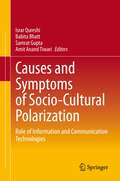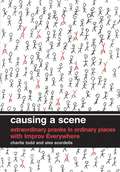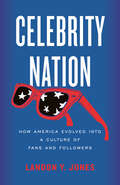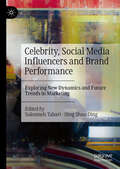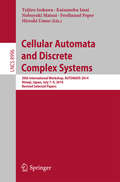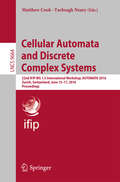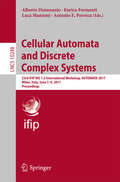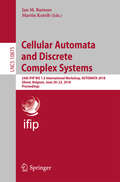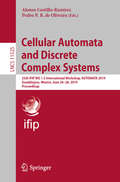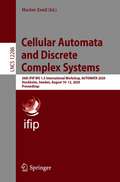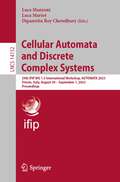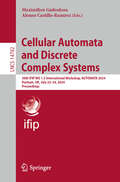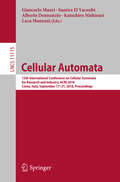- Table View
- List View
Cause Marketing For Dummies
by Joe Waters Joanna MacdonaldCreate a mutually beneficial partnership between nonprofit and for-profit enterprises Cause marketing creates a partnership with benefits for both a nonprofit entity and a business. Written by an expert on cause marketing whose blog, SelfishGiving. com, is a key resource on the subject, this friendly guide shows both business owners and marketers for nonprofits how to build and sustain such a partnership using social media such as Facebook and Twitter. It covers new online tools, how to identify potential partners, tips on engaging your fans, and how to model a campaign on proven successes. Cause marketing is not marketing a cause, but a partnership between business and nonprofit that benefits both This guide offers an easy-to-understand blueprint for finding appropriate partners, planning and setting up a campaign using Facebook, Twitter, and blogs, measuring campaign success, and more Explains online tools such as Quick Response Codes, services like Causon and The Point, and location marketing services including Foursquare, Whrrl, and Gowalla Features case studies that illustrate successful campaign techniques Cause Marketing For Dummies helps both businesses and nonprofits reap the benefits of effective cause marketing.
Cause and Effect Business Analytics and Data Science (Chapman and Hall/CRC Series on Statistics in Business and Economics)
by Jonathan Haughton Dominique Haughton Victor S. LoAmong the most important questions that businesses ask are some very simple ones: If I decide to do something, will it work? And if so, how large are the effects? To answer these predictive questions, and later base decisions on them, we need to establish causal relationships.Establishing and measuring causality can be difficult. This book explains the most useful techniques for discerning causality and illustrates the principles with numerous examples from business. It discusses randomized experiments (aka A/B testing) and techniques such as propensity score matching, synthetic controls, double differences, and instrumental variables. There is a chapter on the powerful AI approach of Directed Acyclic Graphs (aka Bayesian Networks), another on structural equation models, and one on time-series techniques, including Granger causality.At the heart of the book are four chapters on uplift modeling, where the goal is to help firms determine how best to deploy their resources for marketing or other interventions. We start by modeling uplift, discuss the test-and-learn process, and provide an overview of the prescriptive analytics of uplift.The book is written in an accessible style and will be of interest to data analysts and strategists in business, to students and instructors of business and analytics who have a solid foundation in statistics, and to data scientists who recognize the need to take seriously the need for causality as an essential input into effective decision-making.
Cause-Effect Structures: An Algebra of Nets with Examples of Applications (Lecture Notes in Networks and Systems #45)
by Ludwik CzajaThis book presents a new algebraic system whose interpretation coincides with the behaviour of Petri nets, enhanced with an inhibitory mechanism and four time models. Its goal is to provide a formal means of modelling dynamic tasks, and of testing and verifying properties, in contexts characterised by the parallel execution of actions. However, the task description differs from that of Petri nets. The algebra is a quasi-semiring, “quasi” because of its somewhat restricted distributivity axiom. Expressions of this algebra, the cause–effect structures, have a graphic presentation as nets, but with one kind of named nodes, each annotated by two expressions that specify the type of signal reception from predecessors and transmission to successors. Many structural and behavioural properties are stated with proofs, and illustrative sample tasks are included. The book is intended for all those interested or involved in parallel and distributed computing – students, researchers and practitioners alike.
Causes And Consequences Of Map Generalization
by Elsa JoaoThis text describes late-1990s understanding of map generalisation in the context of paper maps and GIS. Its particular value should be in helping to further automate and measure the process of map generalisation.; The research has concentrated on quantifying generalisation effects and on analysing how these effects of generalisation locked into the maps were measured. Elsa Joao's book covers the background to the problems of map generlasation; the methodology developed by the author to investigate the consequences of the map generalisation; a detailed description of results, and a conclusion that draws together consequences for the broader applications to GIS.
Causes and Symptoms of Socio-Cultural Polarization: Role of Information and Communication Technologies
by Israr Qureshi Babita Bhatt Samrat Gupta Amit Anand TiwariThis book explores cultural polarization resultant decline in social cohesion in society and how information and communication technologies exacerbate the cultural polarization through phenomenon such as “echo chambers” of information that damage the quality of online discourse. This book examines the nature of the information that is shared. Further this book identifies how the quality of online discourse and polarization induced through it leads to offline harm and negative outcomes in our society. This book discusses how wide-ranging information exchange on digital media can lead to two scenarios, namely, the formation of the public sphere or the formation of echo chambers. While the public sphere, which promotes greater diversity, is a well-researched domain, substantially less research has been conducted on echo chambers in relation to sociocultural activities, products or services. This book states that polarization induced by the formation and evolution of echo chambers in sociocultural realm such as around epidemic outbreaks, vaccination, healthcare, education, and climate change is an emerging avenue of research due to its enormous impact in the shaping of our society. Therefore, this book argues that understanding the characteristics of sociocultural products related controversies is critical and valuable in developing interventions to reduce unhealthy societal and organizational polarisations. The development of systematic knowledge is required to understand and address such a large scale and complex societal challenge so as to facilitate a deeper understanding and offer solutions to the growing issue of polarization in sociocultural context driven primarily through echo chambers. This book examines how technology enabled social media usage increases, and the complex structural outcomes such as echo chambers are likely to have an increasingly important role in shaping public opinion. This book appeals to readers with interest in developing a deeper and broader understanding of issues and initiatives related to the polarization of opinions on cultural products. These include readers and scholars from various disciplines, along with engaged organizational leaders, activists, policy makers, and common citizens.
Causing a Scene: Extraordinary Pranks in Ordinary Places with Improv Everywhere
by Charlie Todd Alex ScordelisImprov Everywhere has been responsible for some of the most original and subversive pranks of the Internet age.
Cazador de Monstruos Los Chistes y Memes más Divertidos y Épicos
by Joke FactoryVas a descubrir las bromas más divertidas de Cazadores de Monstruos. Este libro está lleno de algunas de las bromas más divertidas de Cazadores de Monstruos. ¡Descubra los temas más populares de Monster Hunter Corporation junto con tontos, ridículos y simplemente divertidos chistes y memes sobre ellos! ¡Desacargue su copia instantáneamente! ¡Comparalo hoy y descubre los chistes más populares para Cazador de Monstruos!
Celebrity Nation: How America Evolved into a Culture of Fans and Followers
by Landon JonesA former People magazine editor reveals how our cult of celebrity has shaped our politics, our culture, and our personal lives—for better or worseFrom the writer and editor who coined the term &“baby boomer&” comes Celebrity Nation, an exploration into how and why fame no longer stems only from heroic achievements but from the number of &“likes&” and shares—and what this change means for American culture. Landon Jones—who spent decades in &“celebrityland&” only to emerge, like Alice, blinking in the sunlight—brings a personal and first-person perspective on fame and its dark underbelly, complicated even further by the arrival of the internet and social media.Jones draws on his experience as the former managing editor of People magazine to bolster his account with profiles of celebrities he knew personally, ranging from Malcolm X to Princess Diana, as well as observations about contemporary social media stars like Kim Kardashian and computer-generated macro-influencer Miquela, a self-proclaimed &“19-year-old Robot living in LA.&” In analyzing the stories of over 75 celebrities, spanning decades and industries, Jones shows how celebrity has been wielded as a weapon of mass distraction to spawn narcissism, harm, and loneliness.And yet, in these stories we also see a path forward. Jones highlights luminaries like Nobel Peace prize winner Maria Ressa and lauded environmental activist Greta Thunberg, who have effected meaningful change not by glorifying themselves but by turning to their communities for action. A lively analysis of celebrity culture&’s impact on nearly every facet of our lives, Celebrity Nation helps us to recognize how the apparatus of fame operates.
Celebrity, Social Media Influencers and Brand Performance: Exploring New Dynamics and Future Trends in Marketing
by Saloomeh Tabari Qing Shan DingCelebrity endorsement has shown to be an effective way enhancing brand-related attitudes, reinforcing behavioural intentions, and shaping brand perceptions. Indeed, companies devote a lot of resources on celebrity endorsement to exploit emotional bonds between consumers and brands in order to accomplish their desired brand image and increase brand awareness, differentiation, and brand loyalty. In short, brands that are endorsed by a favourite celebrity and influencer become more credible and trustworthy. This edited book examines this new era of marketing by focusing on the impact of employing celebrities, SMIs and virtual influencers to endorse the brand as a key advertising tactic. In particular, it focuses on the rise of social media usage and the corresponding changes in advertising strategies in the digital era. As well as exploring this rise of celebrity influencers and their value, the book also takes a critical lens, examining their roles in fuelling the growth of materialism, causing mental health issues among adolescents, and aiding the development of fast fashion. With this balanced and comprehensive approach, this book is an essential resource for anyone interested in the future of advertising.
Cell Formation in Industrial Engineering: Theory, Algorithms and Experiments (Springer Optimization and Its Applications #79)
by Panos M. Pardalos Boris Goldengorin Dmitry KrushinskyThis book focuses on a development of optimal, flexible, and efficient models and algorithms for cell formation in group technology. Its main aim is to provide a reliable tool that can be used by managers and engineers to design manufacturing cells based on their own preferences and constraints imposed by a particular manufacturing system. This tool could potentially lower production costs by minimizing other costs in a number of areas, thereby increasing profit in a manufacturing system. In the volume, the cell formation problem is considered in a systematic and formalized way, and several models are proposed, both heuristic and exact. The models are based on general clustering problems, and are flexible enough to allow for various objectives and constraints. The authors also provide results of numerical experiments involving both artificial data from academic papers in the field and real manufacturing data to certify the appropriateness of the models proposed. The book was intended to suit the broadest possible audience, and thus all algorithmic details are given in a detailed description with multiple numerical examples and informal explanations are provided for the theoretical results. In addition to managers and industrial engineers, this book is intended for academic researchers and students. It will also be attractive to many theoreticians, since it addresses many open problems in computer science and bioinformatics.
Cell Migrations: Causes and Functions (Advances in Experimental Medicine and Biology #1146)
by Caterina A. M. La Porta Stefano ZapperiCell migration plays an important role during development and in many physiological and pathological processes, from wound healing to cancer. This edited volume presents a collection of contributions meant to illustrate the state of the art on this topic from an interdisciplinary perspective.Readers will find a detailed discussion of the properties of individual and collective cell migration, including the associated biochemical regulation and important biophysical and biomechanical aspects. The book includes information on the latest experimental techniques employed to study cell migration, from microfluidics to traction force microscopy, as well as the latest theoretical and computational models used to interpret the experimental data. Finally, the role of cell migration in cancer and in development is also reviewed.The contents of this work should appeal to students and researchers in biology and biophysics who want to get up to date on the latest interdisciplinary development in this broad field of research. The chapters are written in a self-contained form and can also be used as individual articles.
Cell Phone Culture: Mobile Technology in Everyday Life
by Gerard GogginProviding the first comprehensive, accessible, and international introduction to cell phone culture and theory, this book is and clear and sophisticated overview of mobile telecommunications, putting the technology in historical and technical context. Interdisciplinary in its conceptual framework, Cell Phone Culture draws on a wide range of national, regional, and international examples, to carefully explore the new forms of consumption and use of communication and media technology that the phenomenon of mobiles represents. This fascinating biography of an important cultural object: adopts an integrated multiperspective approach considers the mobile phone and its history, production, design, consumption and representation examines the implications in contemporary media convergence such as digital photography an mobile internet. Also reflecting on the challenges and provocations of mobile phone technology and use, this is an absolute must read for any student of media studies, cultural studies or technology.
Cellular Automata Technology: Third Asian Symposium, ASCAT 2024, Durgapur, India, February 29–March 2, 2024, Revised Selected Papers (Communications in Computer and Information Science #2021)
by Enrico Formenti Sukanta Das Mamata DaluiThis book constitutes the refereed conference proceedings of the Third Asian Symposium on Cellular Automata Technology, ASCAT 2024, held in Durgapur, India, during February 29 - March 2, 2024.The 15 full papers presented in this book were carefully reviewed and selected from 33 submissions. The symposium aims to explore the latest advancements, methodologies, and interdisciplinary connections that showcase the versatility and potential impact of cellular automata in contemporary research.
Cellular Automata and Discrete Complex Systems: 20th International Workshop, AUTOMATA 2014, Himeji, Japan, July 7-9, 2014, Revised Selected Papers (Lecture Notes in Computer Science #8996)
by Teijiro Isokawa Katsunobu Imai Nobuyuki Matsui Ferdinand Peper Hiroshi UmeoThis book constitutes revised selected papers from the 20th International Workshop on Cellular Automata and Discrete Complex Systems, AUTOMATA 2014, held in Himeji, Japan, in July 2014. The 10 regular papers included in this volume were carefully reviewed and selected from a total of 25 submissions. It also contains one invited talk in full paper length.
Cellular Automata and Discrete Complex Systems: 22nd IFIP WG 1.5 International Workshop, AUTOMATA 2016, Zurich, Switzerland, June 15-17, 2016, Proceedings (Lecture Notes in Computer Science #9664)
by Matthew Cook Turlough NearyThis volume constitutes the thoroughly refereed proceedings of the 22nd IFIP WG 1. 5 International Workshop on Cellular Automata and Discrete Complex Systems, AUTOMATA 2016, held in Zurich, Switzerland, in June 2016. This volume contains 3 invited talks in full-paper length and 12 regular papers, which were carefully reviewed and selected from a total of 23 submissions. The papers feature research on all fundamental aspects of cellular automata and related discrete complex systems and deal with the following topics: dynamical, topological, ergodic and algebraic aspects; algorithmic and complexity issues; emergent properties; formal language processing; symbolic dynamics; models of parallelism and distributed systems; timing schemes; phenomenological descriptions; scientific modeling; and practical applications.
Cellular Automata and Discrete Complex Systems: 23rd IFIP WG 1.5 International Workshop, AUTOMATA 2017, Milan, Italy, June 7-9, 2017, Proceedings (Lecture Notes in Computer Science #10248)
by Enrico Formenti Alberto Dennunzio Luca Manzoni Antonio E. PorrecaThis volume constitutes the thoroughly refereed proceedings of the 23rd IFIP WG 1. 5 International Workshop on Cellular Automata and Discrete Complex Systems, AUTOMATA 2017, held in Milan, Italy, in June 2017. The 14 full papers presented together with one full-length invited paper and 2 invited talk abstracts were carefully reviewed and selected from a total of 28 submissions. The papers feature research on correlated models of automata. The topics include aspects and features of such models: dynamics; topological, ergodic, and algebraic aspects; algorithmic and complexity issues; emergent properties; formal languages; symbolic dynamics; tilings; models of parallelism and distributed systems; timing schemes; synchronous versus asynchronous models; phenomenological descriptions; scientific modelling; practical applications.
Cellular Automata and Discrete Complex Systems: 24th IFIP WG 1.5 International Workshop, AUTOMATA 2018, Ghent, Belgium, June 20–22, 2018, Proceedings (Lecture Notes in Computer Science #10875)
by Jan M. Baetens Martin KutribThis volume constitutes the thoroughly refereed proceedings of the 24th IFIP WG 1.5 International Workshop on Cellular Automata and Discrete Complex Systems, AUTOMATA 2018, held in Ghent, Belgium, in June 2018.The 10 regular papers presented in this book were carefully reviewed and selected from a total of 16 submissions. The papers highlight the major advances in the field and the development of new tools, support the development of theory and applications of CA and DCS and identify and study within an inter- and multidisciplinary context, the important fundamental aspects, concepts, notions and problems concerning CA and DCS.
Cellular Automata and Discrete Complex Systems: 25th IFIP WG 1.5 International Workshop, AUTOMATA 2019, Guadalajara, Mexico, June 26–28, 2019, Proceedings (Lecture Notes in Computer Science #11525)
by Alonso Castillo-Ramirez Pedro P. B. de OliveiraThis volume constitutes the refereed proceedings of the 25th IFIP WG 1.5 International Workshop on Cellular Automata and Discrete Complex Systems, AUTOMATA 2019, held in Guadalajara, Mexico, in June 2019.The 7 regular papers presented in this book were carefully reviewed and selected from a total of 10 submissions. The topics of the conference include deal with dynamical, topological, ergodic and algebraic aspects of CA and DCS, algorithmic and complexity issues, emergent properties, formal languages, symbolic dynamics, tilings, models of parallelism and distributed systems, timing schemes, synchronous versus asynchronous models, phenomenological descriptions, scientic modeling, and practical applications.
Cellular Automata and Discrete Complex Systems: 26th IFIP WG 1.5 International Workshop, AUTOMATA 2020, Stockholm, Sweden, August 10–12, 2020, Proceedings (Lecture Notes in Computer Science #12286)
by Hector ZenilThis volume constitutes the refereed post-conference proceedings of the 26th IFIP WG 1.5 International Workshop on Cellular Automata and Discrete Complex Systems, AUTOMATA 2020, held in Stockholm, Sweden, in August 2020. The workshop was held virtually.The 11 full papers presented in this book were carefully reviewed and selected from a total of 21 submissions. The topics of the conference include dynamical, topological, ergodic and algebraic aspects of CA and DCS, algorithmic and complexity issues, emergent properties, formal languages, symbolic dynamics, tilings, models of parallelism and distributed systems, timing schemes, synchronous versus asynchronous models, phenomenological descriptions, scientific modeling, and practical applications.
Cellular Automata and Discrete Complex Systems: 29th IFIP WG 1.5 International Workshop, AUTOMATA 2023, Trieste, Italy, August 30 – September 1, 2023, Proceedings (Lecture Notes in Computer Science #14152)
by Dipanwita Roy Chowdhury Luca Manzoni Luca MariotThis book constitutes the proceedings of the 29th IFIP WG 1.5 International Workshop on Cellular Automata and Discrete Complex Systems, AUTOMATA 2023, which took place in Trieste, Italy, in August/September 2023. For AUTOMATA 2023, 7 full papers have been carefully reviewed and selected from 11 submissions. The book also contains 3 full papers from AUTOMATA 2022, which have been selected from a total of 18 submissions. In addition, the proceedings contain one invited talk in full paper length from AUTOMATA 2023.
Cellular Automata and Discrete Complex Systems: 30th IFIP WG 1.5 International Workshop, AUTOMATA 2024, Durham, UK, July 22–24, 2024, Proceedings (Lecture Notes in Computer Science #14782)
by Alonso Castillo-Ramirez Maximilien GadouleauThis book constitutes the proceedings from the 30th IFIP WG 1.5 International Workshop on Cellular Automata and Discrete Complex Systems, AUTOMATA 2024, held in Durham, United Kingdom, during July 22-24, 2024. The 10 full papers presented in these proceedings were carefully reviewed and selected from 18 submissions. These include papers from the 4 invited talks given by Alberto Dennunzio, Luca Mariot, Elisabeth Remy, and Agnieszka Rusinowska at the conference.
Cellular Automata and Groups (Springer Monographs in Mathematics)
by Tullio Ceccherini-Silberstein Michel CoornaertThis unique book provides a self-contained exposition of the theory of cellular automata on groups and explores its deep connections with recent developments in geometric and combinatorial group theory, amenability, symbolic dynamics, the algebraic theory of group rings, and other branches of mathematics and theoretical computer science. The topics treated include the Garden of Eden theorem for amenable groups, the Gromov–Weiss surjunctivity theorem, and the solution of the Kaplansky conjecture on the stable finiteness of group rings for sofic groups. Entirely self-contained and now in its second edition, the volume includes 10 appendices and more than 600 exercises, the solutions of which are presented in the companion book Exercises in Cellular Automata and Groups (2023) by the same authors. It will appeal to a large audience, including specialists and newcomers to the field.
Cellular Automata: 12th International Conference on Cellular Automata for Research and Industry, ACRI 2016, Fez, Morocco, September 5-8, 2016. Proceedings (Lecture Notes in Computer Science #9863)
by Samira El Yacoubi Jaroslaw Wąs Stefania BandiniThis book constitutes the refereed proceedings of the 7th International Conference on Cellular Automata for Research and Industry, ACRI 2006. The book presents 53 revised full papers and 19 revised poster papers together with 6 invited lectures. Topical sections include CA theory and implementation, computational theory, population dynamics, physical modeling, urban, environmental and social modeling, traffic and boolean networks, multi-agents and robotics, as well as crowds and cellular automata, and more.
Cellular Automata: 13th International Conference on Cellular Automata for Research and Industry, ACRI 2018, Como, Italy, September 17–21, 2018, Proceedings (Lecture Notes in Computer Science #11115)
by Giancarlo Mauri Samira El Yacoubi Alberto Dennunzio Luca Manzoni Katsuhiro NishinariThis book constitutes the proceedings of the 13th International Conference on Cellular Automata for Research and Industry, ACRI 2018, held in Como, Italy, in September 2018. The 47 full papers presented in this volume were carefully reviewed and selected from 64 submissions.This volume contains invited contributions and accepted papers from the main track and from the three organized workshops. The volume is organized in the following topics: biological systems modeling; simulation and other applications of CA; multi-agent systems; pedestrian and traffic dynamics; synchronization and control; theory and cryptography; asynchronous cellular automata; and crowds, traffic and cellular automata.
Cellular Automata: 14th International Conference on Cellular Automata for Research and Industry, ACRI 2020, Lodz, Poland, December 2–4, 2020, Proceedings (Lecture Notes in Computer Science #12599)
by Georgios Ch. Sirakoulis Stefania Bandini Luca Manzoni Tomasz M. Gwizdałła Krzysztof PodlaskiThis book constitutes the refereed proceedings of the 14th International Conference on Cellular Automata for Research and Industry, ACRI 2020, which took place in Lodz, Poland, during December 2-4, 2020. The 24 full and 3 short papers presented in this volume were carefully reviewed and selected from 40 submissions. They were organized in topical sections named: theory and cryptography, modeling and simulation, and disease spreading dynamics.
